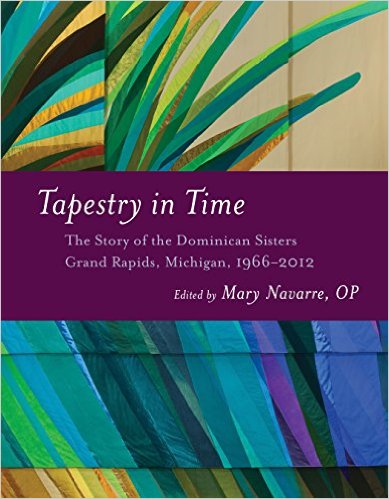
This compelling, collaborative history chronicles American Dominican sisters’ experience of significant changes following the Second Vatican Council’s call for ressourcement and aggiornamento. I am privileged to know many religious sisters, and this book invited me to more intimately participate in their congregations’ energetic, transformative, and sometimes disorienting reforms in the decades following the Council.
This is a story that needs to be told by those who lived it.
Joining other recent works celebrating the immense—but often overlooked—contributions and lived history of religious and monastic women, this book paints a vividly detailed portrait of how the sweeping reforms affected sisters’ individual lives and their communities. A sequel to Period Pieces: An Account of the Grand Rapids Dominicans 1853–1966 by archivist Mona Schwind (Grand Rapids: Sisters of St. Dominic, 1991), this work uses primary, experiential sources to discuss events within the changing theological contexts that prompted them.
Among these Dominicans, response to the Council inspired extraordinary transformations of liturgy, spirituality, education, community life, and ministry, each considered in four distinct parts. An introductory preamble situates the volume in the upheavals of the twentieth century and reflects on how the sisters’ varied responses to change resemble the community-stitched liturgical tapestry in the renovated Marywood Chapel. Like the textile, these interwoven strands represent the simultaneous unity of the congregation and the diversity of its members.
Where once a clear hierarchy, large group living, and a monastic-styled interior focus had structured daily life for centuries, Vatican II called these sisters beyond “the trials of childhood dependency and the adolescent turbulence of fierce independence” to “the give and take of adults living and dying in interdependence and mutuality” (p. 149). Turning to the originating sources of Scripture and the Dominican tradition, and guided by the signs of the times, these sisters boldly implemented reforms through a collegial creativity and dedicated commitment to “find Dominic’s tune for this nuclear space age” (p. 61).
Part 1: Challenge, Innovation, and Experimentation
Part 1 discusses landmark changes to personal and community prayer. Experimentation with different forms of prayer remained distinctly faithful to Saint Dominic’s ecclesial—yet innovative—tradition, allowing measured experimentation with new ideas and practices. A section on sisters’ first use of the vernacular English and Spanish in communal liturgy allows post-Vatican II readers the opportunity to discover this beauty as if for the first time.
Dominicans’ intense involvement in developing inclusive language for sacred texts and psalmody followed, along with other innovations all eyeing retrieval of order’s original, founding spirit. Discovery and development of charismatic gifts, liturgical dance, expanded annual retreats, architectural renovations, and a particular emphasis on sisters’ ministry of preaching led to a number of pioneering educational conferences and institutes. Uniformity of observance gave way to collaboration, dialogue, creativity, diversity, and social consciousness, yielding a renewed focus on the Dominican charism of study.
Part II: Shifting Identity and Mission
Covered in Part II, intellectual and spiritual formation involved extensive revision of sisters’ approach to theology and its concrete application in the world. Inspired by Cardinal Suenen’s Nun in the World: Religious and the Apostolate (London: Burns & Oates,1963), insightful leaders like Sister Aquinas Weber (prioress 1966-1972) guided the congregation through the challenging implementation of Perfectae Caritatis. The pre-Vatican II emphasis on external symbols such as uniform clothing, gave way to a deepened understanding of sisters’ essential identity and mission, and expanded their potential in professional theology and secular arts and sciences.
Parts III & IV: Interpretation, Conflict, and New Horizons
Not surprisingly, Part III on the common life and Part IV on ministry both reflect the profound conceptual shifts underlying post-Conciliar reform. Issues of conflict over the many changes reflected sisters’ varied interpretations, and disagreements arose at times. For example, modification of the traditional Dominican habit, essentially unchanged since its medieval design, required prolonged discussion, debate, and experimentation. Living in non-convent styled houses without an appointed superior offered another difficulty that required finding new ways of intentional community life, “not dependent on common walls, but common hearts” (p. 145).
As Vatican II opened the windows to the world, sisters opened their daily lives to others, religious or laity, including those who had left their community and lay associates. Formation of a collaborative novitiate and numerous coalitions assisted sisters in an expanded vision for Aquinas College while supporting establishment of missions in New Mexico, and Chimpote, Peru while serving in varied ministries of peacemaking and justice worldwide.
Remaining Faithful
Narrator Mary Navarre concludes this compelling, well edited and exquisitely organized compilation of theologically grounded memoirs by reflecting on why “this is a story that needs to be told by those who lived it” (p. 282). This approach succeeds in opening an illuminating portal into both the profound and mundane transformations of post-Conciliar Dominican life. While some readers may wish for inclusion of critique of the Roman Catholic hierarchy’s recent investigation of the American Leadership Conference of Women Religious, Navarre insists that while “investigations and assessments flare up, come and go” (p. 284), sisters are more imminently concerned with living authentic lives of deep prayer, study, common life, and socially conscious service, while viewing “always in the distance—the shadow of the cross” (p. 286).
TAPESTRY IN TIME: The Story of the Dominican Sisters, Grand Rapids, Michigan, 1966-2012, edited by Mary Navarre. ISBN 978-0-8028-7255-5. Eerdmans, 2015, pp. 336. $20.00 pb.
Reviewed by Neville Ann Kelly. Excerpts from this review were originally published in Catholic Books Review.
